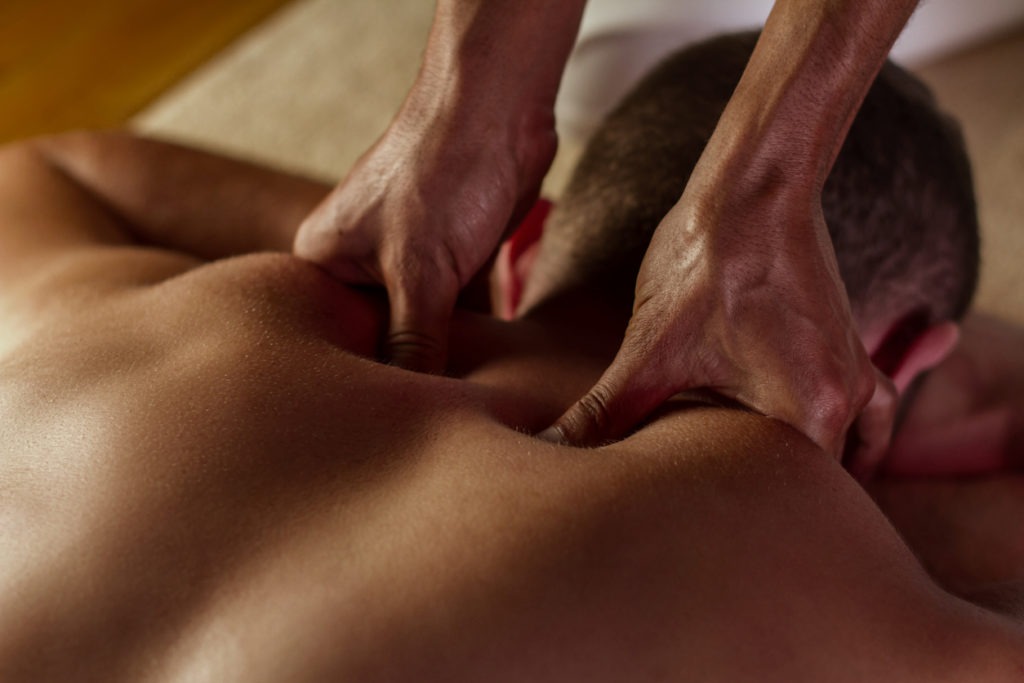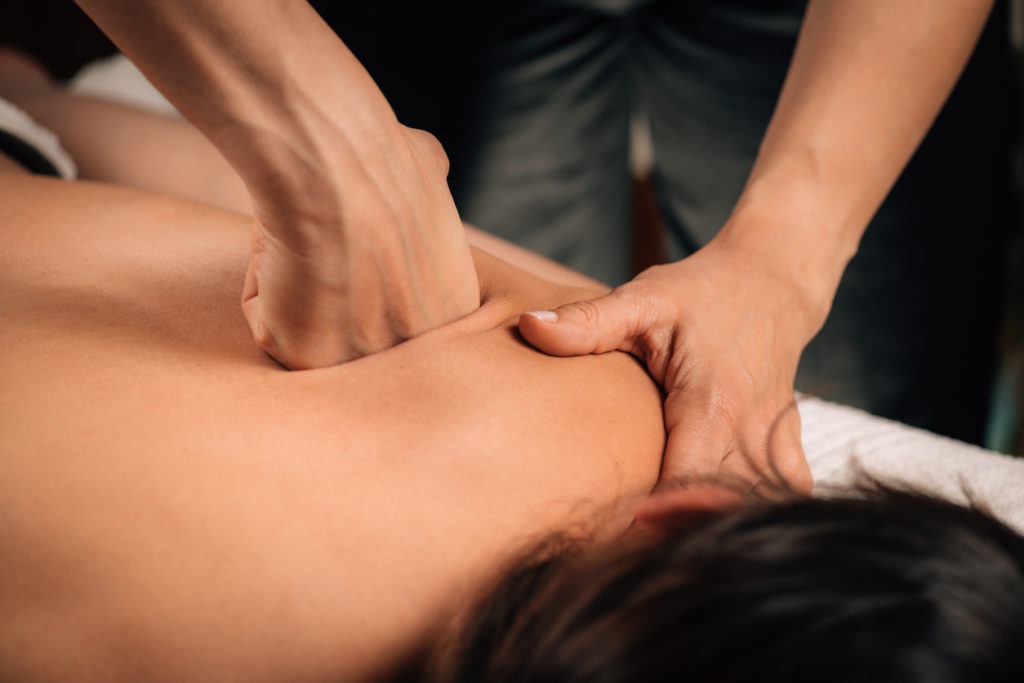If you experience stress, pain, and muscle soreness or feel like your body is a giant knot of tense muscles – a deep-tissue massage is probably what you need.
Massage as a therapy has been around for thousands of years. Many ancient cultures, including Persians, Hindus, and Egyptians, used massage to cure different ailments and diseases. It’s also widely accepted as a tool for relaxation and stress relief and for alleviating muscle pain and soreness. It can even help with symptoms of bursitis, arthritis, fatigue, high blood pressure, diabetes, depression, and other various health conditions.
What is a Deep Tissue Massage?
Deep tissue massage is one of the most popular massage techniques that targets deep layers of muscles and surrounding tissues. It’s not just a Swedish massage with harder pressure or deeper strokes.
People often choose this massage to treat chronic pain and sports injuries. It involves applying sustained pressure using deep and slow strokes to work the inner layers of the muscles and connective tissues. It helps break up scar tissue after an injury and reduces muscle and tissue tension. It also promotes faster healing by reducing inflammation and increasing blood flow.
During a deep tissue massage, a massage therapist will use a technique that helps reduce severe muscle soreness. The therapist will also single out different areas of pain and tension. The tougher touch and pressure help them work out the knots in the sub-layer of muscles and fascia.
Deep Tissue Massage vs. Swedish Massage
Deep tissue massage differs from other popular massage styles, like Swedish and reflexology. Both use the same strokes, but they have different purposes and uses. Here’s how they are different:
| Deep Tissue Massage | Swedish Massage | |
| Purpose | To treat chronic muscle pain and sports-related injuries | To promote relaxation and reduce muscle tension caused by everyday activities |
| Massage technique and pressure | Involves the use of fingers and palms for kneading | Involves the use of fingers and palms for kneading |
| May require use of the elbows and forearms to apply deeper pressure | Gentler and uses less tension | |
| Area of focus | Targets the inner layers of the muscles | Targets the superficial layers of muscles |
In summation, deep tissue massage is mainly used for helping people with sports-related injuries and chronic pain. If you just want to Zen out and relax, it’s better to try Swedish massages or other massage styles, like Thai, reflexology, and aromatherapy.
Benefits of a Deep Tissue Massage
Deep tissue massage offers both physical and psychological benefits. Unlike other massage techniques, it focuses on relaxation to help treat muscle pain and improve stiffness. But it can also help you unwind your mind, too.
Almost anyone can benefit from a deep-tissue massage, but it’s particularly great for athletes and people with musculoskeletal issues. Commonly affected areas of the body include the neck, butt, calves, shoulders, and lower back, and deep tissue massage can help aid the soreness and knots in these areas.
Deep tissue massage can also help those who have sports injuries, tennis elbow, fibromyalgia, plantar fasciitis, piriformis syndrome, postural problems, high blood pressure, and sciatica.
Here is what a deep tissue massage can do for you:
1. It helps relieve stress.
Deep tissue massage is a good stress reliever. Whether you’re experiencing stress at work or at home, getting a massage is a great way to relax your mind and body for an extended period of time. It can help lower cortisol levels that cause stress and increase oxytocin levels, a hormone that relaxes the body and produces soothing effects. It can also help increase the production of serotonin, promoting good feelings of happiness.
It can also relieve physical symptoms of stress, such as tight muscles, shoulders, and tension headaches. A deep tissue massage can help solve these issues and help your body relax.
2. It alleviates bodily pain.
There are several conditions that can be treated with a deep tissue massage. Chronic pain caused by plantar fasciitis, arthritis, sciatica, and fibromyalgia, as well as back pain and stiff necks, can be relieved by massage therapy.
Muscle tension that often occurs with chronic pain can be lessened with a deep tissue massage, as it can help loosen the tight tissue clusters that cause pain. Research reported that deep tissue massage is more effective for alleviating chronic pain than medications and other treatments.
3. It lowers high blood pressure.
Deep tissue massage, like other kinds of massages, reduces stress and tension that can impact blood pressure. Research has shown that sports massage may help reduce heart rate and high blood pressure. Also, massage positively impacts arterial, systolic, and diastolic blood pressure.
4. It reduces arthritis symptoms.
Deep tissue therapy can treat many symptoms of arthritis, like stiffness, pain, limited range of motion, and sleep issues. Moderate pressure can help ease tension and reduce arthritis pain, making it easier for people with arthritis to move around. It can also help reduce sleep issues by alleviating pain that may cause arthritis patients to have difficulty sleeping at night.
5. It breaks up scar tissues.
Where scar tissues reside, there’s often chronic pain and stiffness. A deep tissue massage can help break it up by improving circulation to improve the flexibility of moving around the area of the scar tissue. A deep-tissue massage may help minimize scar tissue if you are recovering from surgery.
6. It rehabilitates injured muscles.
Muscle injury can cause tightness and twisting. A deep tissue massage can help correct it while facilitating the movement of toxins from the muscles.
Deep tissue massage is frequently used for treating sports-related injuries, as athletes often incorporate this type of massage into their recovery protocols. Deep tissue massage can help reduce muscle fatigue, delay the onset of muscle soreness, and prevent injuries.
7. It helps recovery after injury.
Research suggests that both deep and soft tissue release aid recovery after an injury, especially an ankle injury. Massaging can aid in relieving stiffness and pain, restoring range of motion, speeding up the healing of sprains and strains, and improving circulation by reducing swelling or fluid buildup around the injury.
8. It helps with labor and delivery.
Deep tissue massage can help control the pain of women during labor, preventing too much strain and fatigue in a pregnant woman’s body as she is about to give birth.
However, before labor, it’s better to opt for a type of massage with a gentler, softer pressure instead of a deep tissue massage. Prenatal massages are a great way for women to relax and ease tight muscles. It also helps women minimize anxiety, depression, and back and leg pain, usually during pregnancy.
Research also suggests that women who had regular massages before and during labor experience less pain during childbirth and recovery than those who did not receive regular massages. Massages can also help shorten labor time, and pregnant women who frequently receive massages have shorter labor time than women who do not.
What Happens During a Massage?
Before starting the deep tissue massage, your massage therapist will ask about your problem areas. Depending on your preferences, a deep tissue massage may involve just one area or your entire area. Once you’re ready, you’ll be asked to lie on the back or stomach under a sheet. You will be asked to undress to the degree you’re comfortable with.
The therapist will start with a lighter touch to warm up your muscles, and then once it’s warmed up, they will start targeting the painful areas. They will use stroking and deep kneading with different amounts of intense pressure. Just let them know if you want them to ease up or press harder.
Sometimes, these kinds of massages are uncomfortable or even painful. Discomfort is normal, but if you’re in intense pain, you have to tell your therapist to tone it down.
Some spas come with heated massage tables and fans in the room for extra comfort. Just let your therapist know your preferences before they get to work.
Are there Any Side Effects?
After your deep tissue massage, you may feel sore for a day or two. A heating pad or a cold pack can help with this. You can also use a topical analgesic.
Some people feel sick after a massage. Symptoms may include tiredness, headache, nausea, and dizziness.
Though deep tissue massage is generally safe, this massage technique uses a very firm pressure, which may not be safe for everyone. Ask your doctor for a go signal before having a deep tissue massage if you:
- Have a blood clotting disorder
- Are you taking blood thinners
- Have cancer or undergoing cancer treatment
- Have you undergone any recent surgery
- Have skin conditions and wounds
- Are at an increased risk of injury, such as bone fractures
- Have hernia
- Are of old age
If you have osteoporosis or cancer that has spread to the bones, you should avoid deep tissue massage, as the firm pressure may cause fractures. You may also want to hold off on this kind of massage if you’re pregnant, as it may cause premature labor. If you have an open wound or skin infection of any kind, reschedule your massage appointment to avoid developing a new infection or making the existing one worse.


